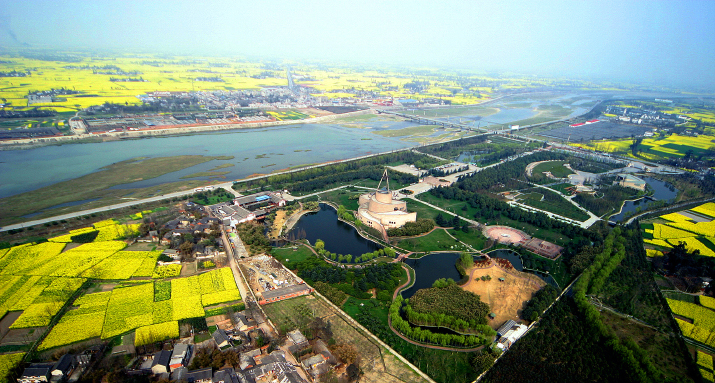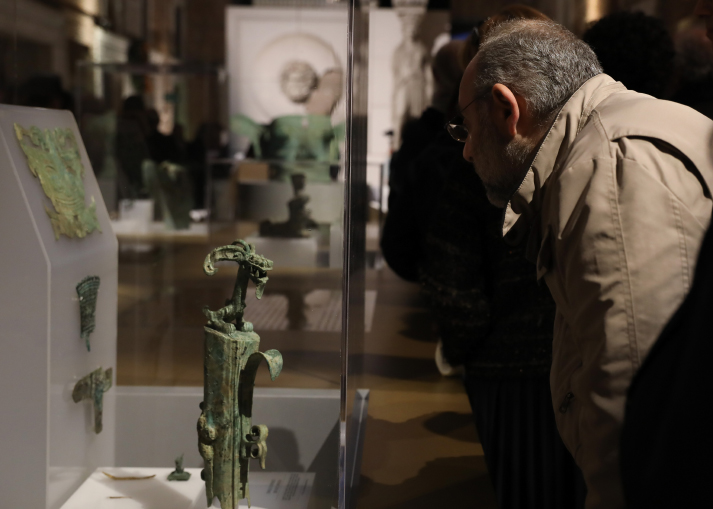| Lifestyle |
| New discovery leads to fresh excavation at ancient archaeological site in southwest China | |
|
|
 The Sanxingdui site in Guanghan, Sichuan Province, southwest China (XINHUA)
Guo Hanzhong, an expert restorer of cultural relics, traces his interest in his work to Sanxingdui, an archaeological site in southwest China that was a treasure trove of Bronze Age culture artifacts.
The site in Guanghan, Sichuan Province, was accidentally discovered in 1929 by a local farmer while digging a ditch, when he unearthed a piece of bright jade. An official archaeological excavation started decades later and in 1986, archaeologists uncovered two pits whose treasures changed the historical belief that the central plains of the Yellow River were the sole birthplace of Chinese culture. The two pits were used for sacrificial ceremonies, proved by the presence of more than 1,000 priceless objects that had been ritually broken and burnt. They included gold masks, bronze ware, jade tablets and ivory items. The two pits were filled up and became tourist attractions. In December 2019, during regular maintenance, the existence of a bronze artifact was confirmed, indicating there could be a new pit. The tourism facilities were dismantled and a survey started, showing the existence of six new pits between the previous two and it was decided to start fresh excavation in early September.  The giant sacred bronze tree discovered in Sanxingdui (XINHUA)
Ancient enigma The 12-square-km Sanxingdui site, the largest of its kind in southwest China with the oldest history, verifies the existence of an ancient kingdom recorded in literature, the Shu Kingdom. It is speculated to have been a vassal state during the Shang and Zhou dynasties (about 1600-256 B.C.). The Sanxingdui bronze and gold masks, including several giant ones, became the face of the enigmatic Sanxingdui culture. Distorted with protruding eyes and giant ears, they are similar to modern-day concept of aliens. The artifacts, showing advanced workmanship, especially in bronze, are the relics of a civilization that estimatedly emerged, prospered and then vanished roughly between 3,000 and 5,000 years ago. Guo's family lived near the pits. Some members of the Sichuan Provincial Cultural Relics and Archaeology Research Institute who were part of the excavation team, rented rooms from them and interactions with the researchers triggered the little boy's interest in archaeology, especially in the study of Sanxingdui culture. Today, he is a master restorer at the Sanxingdui National Archaeological Park in Guanghan. Guo hopes the work he and his team are doing will one day help find the answers. One of the restorations he is most proud of is a bronze tree, a sacred object. It is nearly 4 meters high, the largest bronze item ever found in the world. It took the team six years to put together the colossal tree though its top parts are still missing. The tree is divided into three sections, with dragons encircling it while nine birds perch on the branches. The mainstream view in the academic world is that the Sanxingdui bronzes are similar to the Shang Dynasty (about 1600-1046 B.C.) relics from the central plain civilization. They are all sacrificial objects. For instance, Shi Jingsong, a researcher at the Institute of Archaeology, Chinese Academy of Social Sciences, told Life Week that one of the pits had bronze heads and gold scepters, which were probably symbols of royalty. The other had sacred trees and birds, and a bronze item shaped like the sun. It probably represented worship of the sun. "So, theocracy and aristocracy ruled the early state of Sanxingdui together," Shi said.  A visitor looks at a cultural relic from the Sanxingdui site at a exhibition held in Rome, Italy, on March 25 (XINHUA)
New expectations Since the discovery of Sanxingdui, there have been numerous questions about it. How long did the culture exist? What caused its end? Why are its relics so unique? Due to the lack of written records, it had been difficult to find out more about the culture. However, the more sacrificial pits leading to a new phase of excavation since September 8 are anticipated to provide more information. Sanxingdui is speculated to have disappeared around 1200 B.C. Around the same time, a similar civilization sprang up in Jinsha, nearly 50 km away. Relics of the Jinsha site that can be dated back to over 3,000 years ago prove that it also belonged to the ancient Shu Kingdom. "It is hard to imagine a civilization that created such a work of art for a sacrificial ceremony," Cui Cui, a visitor at the Sanxingdui Museum, said. During that period, the vassal states in the central plains were upgrading their weapons. However, people in the fertile Sichuan Basin were making exquisite ritual items, including jade objects. That indicated the characteristics of the culture and people in the Shu Kingdom, she said. She hoped the museum would display more relics. If Sanxingdui is shown to have had links with the Jinsha site, , it would be easier to understand the ancient Shu civilization, Cui said. "The ancient Shu civilization and its ancestors are an important part of the original Chinese civilization," Lei Yu, Director of the Sanxingdui Workstation of Sichuan Cultural Relics and Archaeology Research Institute, told CCTV. "Some of their bronze designs as well as dragons and jade objects are common elements in the Chinese culture." Lei hopes future discoveries will promote research on the site and its culture. His team plans to complete the excavation in three months. The Sanxingdui period marks the most prosperous period for the ancient Shu Kingdom, Lei said. "It also demonstrates the diversity of Chinese civilization in its early stages. Its emergence proves that the upper reaches of the Yangtze were also a cradle of the Chinese civilization as well as the Yellow River basin." "The new discovery is hoped to create a new upsurge in Sanxingdui research," Sun Hua, professor of the School of Archaeology and Museology, Peking University, told Life Week. "Although we don't have any written documents from the pits, their contents tell us about the status of the people the sacrifices were meant for," Sun said. (Print Edition Title: On the Trail of a Mysterious Culture) Copyedited by Sudeshna Sarkar Comments to liqing@bjreview.com |
|
||||||||||||||||||||||||||||
|